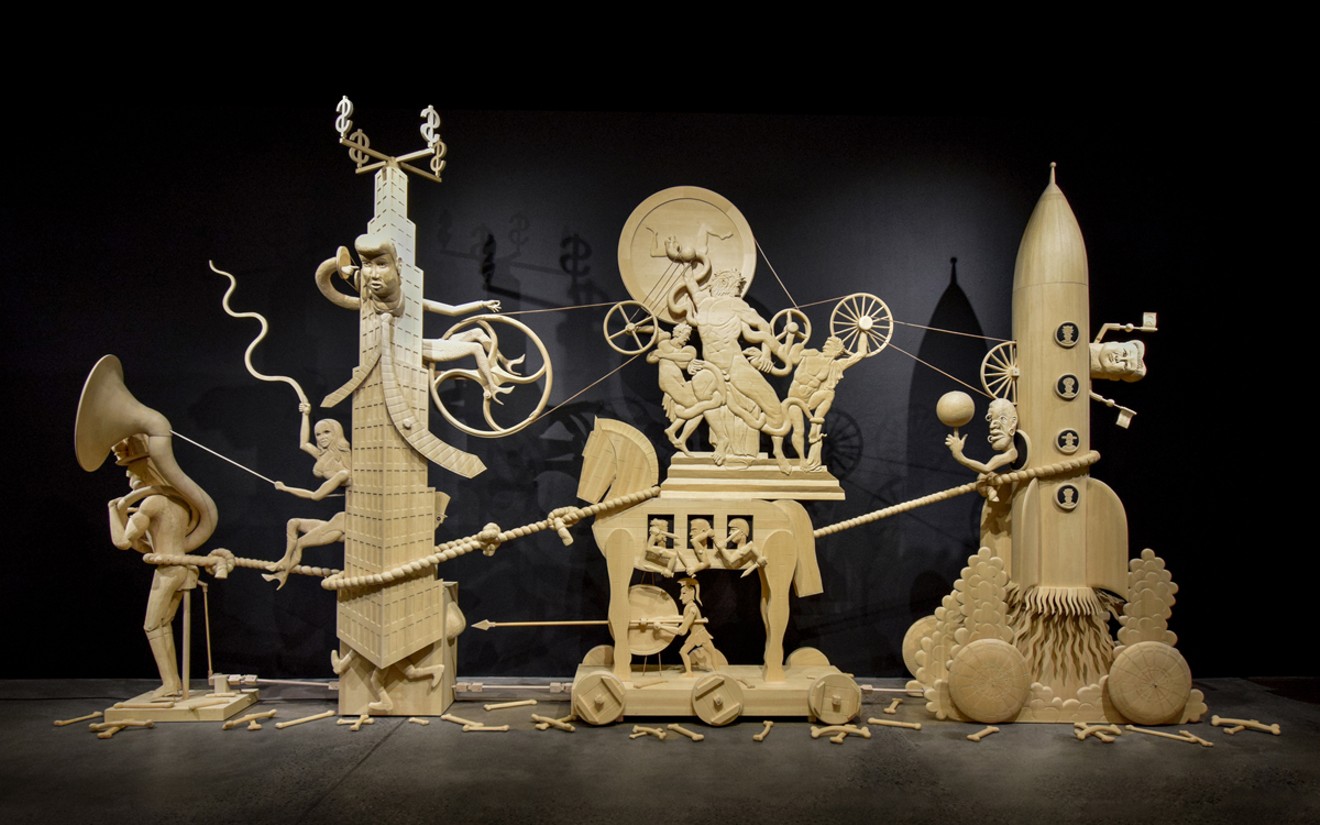The first — and most over-the-top — solo is John Buck: New and Recent Work. The Iowa-born Buck, who now splits his time between Bozeman and Hawaii, was already famous for his prints and wall panels of enigmatically rendered subjects, as well as sculptures of figures, their heads replaced with evocative objects, when he began to create gigantic moving contraptions a few years ago. His Robischon show opens with an enormous one, “The March of Folly,” which lays out a complex narrative, conflating ancient Greek myths with contemporary politics.

"Flying Horse," cast bronze; "The School of Paris," wood, mixed materials and motor, by John Buck.
Courtesy of Robischon Gallery
Another kinetic sculptural group included in the Buck solo is “The School of Paris,” which deconstructs art history. Other smaller pieces, such as “Flying Horse,” a bronze of a nude running figure, its head replaced by an open oval shape topped by a Chinese-style flying horse, are also part of the mix. The more contained size of this sculpture is not all that’s distinctly different from the aforementioned mechanized pieces: “Flying Horse” is done in bronze with a deep, rich patina, while the machines are left in unfinished wood.

“Aspiration” (from left), “Tether” and “A Sense of Belonging,” by Walter Robinson, wood and mixed materials.
Courtesy of Robischon Gallery
As you walk into the space, “Tether” metaphorically hits you in the face. The sculpture is a dismembered, oversized leg that seems to be coming through the wall. The leg is wearing an enormous, pristine white ice skate and zebra-skin leggings along with an ankle monitor, as though the piece were under house arrest; the back of the skate sits on the floor, with the sawtooth edge of the blade sticking up at an angle, threatening the viewer. It’s simultaneously whimsical and disturbing. The same goes for “Aspiration,” a toppled, binge-drinking snowman. If these sculptures aren’t weird enough, the show’s title pieces, “Magical Thinker (male)” and “Magical Thinker (female),” are two adorned straitjackets hanging from coat racks in the middle of the space, which lets us know that insanity really is one of the topics here.
The solo in the galleries that run parallel to the entry spaces occupied by the Bucks is Paco Pomet: New Work. Some of these paintings have a sort of Wild West feel, so it was a surprise to learn that Pomet lives in Spain (this is his first show at Robischon). He must be riffing on old-timey European kitsch rather than the Rocky Mountain variety. Pomet conveys traditional scenes in pseudo-monochromes, then infuses parts of the compositions with dazzling, contrasting lighting effects. In “Eclipse,” a log cabin, the painting’s central element, is seen at twilight. There’s a bluish tint cast on it and on the surrounding woods, but the interior of the cabin is glowing, as seen through the window and the front door, which vibrates with bright yellow. Peering into the cabin is a sprightly cartoon character depicting the moon. The style of the cabin is traditional realism, but the moon character has a pop-art look. That collision of disparate styles is seen in all of these Pomet paintings, but never more clearly than in “Dualists,” in which two men dressed in clothes of a century ago face off not with swords or axes, but with Star Wars-type lightsabers that glow intensely against the dark colors in which the scene is laid out.

"The Illusion of Emotion" and "Scapegoat," by Fred Storehouse, both acrylic on panel.
Courtesy of Robischon Gallery
They even have a spiritual air, as though some Holy Roller preacher, an untrained artist, had been guided by the hand of God — perhaps unwillingly, perhaps just in his mind — to paint. In “Unknown,” for example, the artist, conveyed in a brutal rendering, holds a raccoon while his head is covered in articulated beads of sweat. A caption that runs above the scene is a musing on whether he is up to some task. Even more possessed by religious fervor is “Search for the Finish,” in which a beast is seen running off with a bag of money while the artist plays the devil.
The four shows at Robischon create a funhouse atmosphere in the enormous gallery, but one that’s drop-dead serious underneath.
John Buck, Paco Pomet, Fred Stonehouse and Walter Robinson, through November 3, Robischon Gallery,1740 Wazee Street, 303-298-7788, robischongallery.com.












